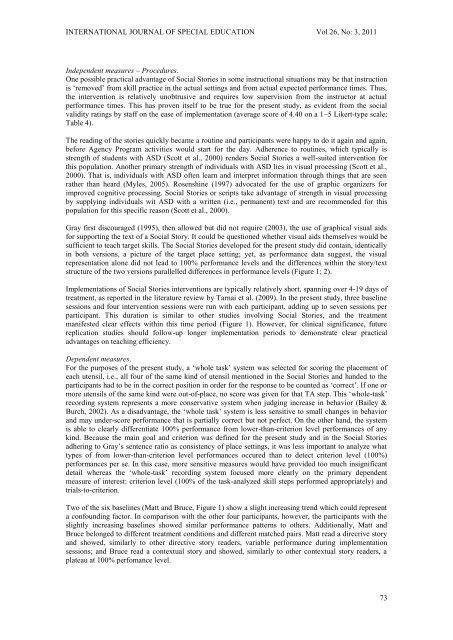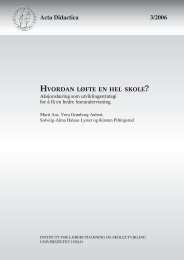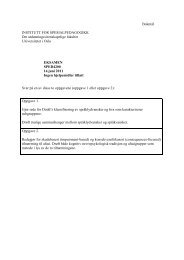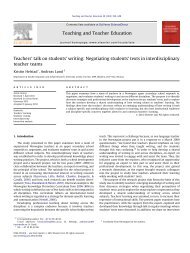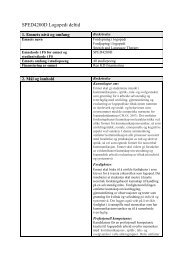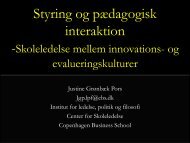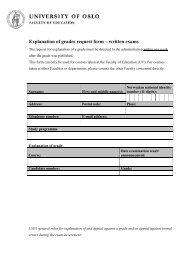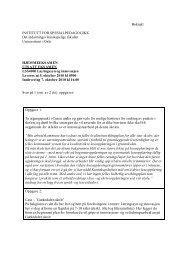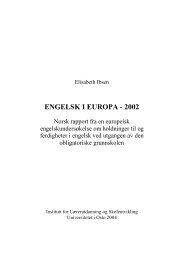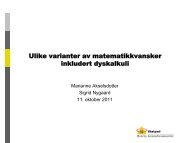International Journal Special Education
International Journal Special Education
International Journal Special Education
Create successful ePaper yourself
Turn your PDF publications into a flip-book with our unique Google optimized e-Paper software.
INTERNATIONAL JOURNAL OF SPECIAL EDUCATION Vol 26, No: 3, 2011Independent measures – Procedures.One possible practical advantage of Social Stories in some instructional situations may be that instructionis ‘removed’ from skill practice in the actual settings and from actual expected performance times. Thus,the intervention is relatively unobtrusive and requires low supervision from the instructor at actualperformance times. This has proven itself to be true for the present study, as evident from the socialvalidity ratings by staff on the ease of implementation (average score of 4.40 on a 1–5 Likert-type scale;Table 4).The reading of the stories quickly became a routine and participants were happy to do it again and again,before Agency Program activities would start for the day. Adherence to routines, which typically isstrength of students with ASD (Scott et al., 2000) renders Social Stories a well-suited intervention forthis population. Another primary strength of individuals with ASD lies in visual processing (Scott et al.,2000). That is, individuals with ASD often learn and interpret information through things that are seenrather than heard (Myles, 2005). Rosenshine (1997) advocated for the use of graphic organizers forimproved cognitive processing. Social Stories or scripts take advantage of strength in visual processingby supplying individuals wit ASD with a written (i.e., permanent) text and are recommended for thispopulation for this specific reason (Scott et al., 2000).Gray first discouraged (1995), then allowed but did not require (2003), the use of graphical visual aidsfor supporting the text of a Social Story. It could be questioned whether visual aids themselves would besufficient to teach target skills. The Social Stories developed for the present study did contain, identicallyin both versions, a picture of the target place setting; yet, as performance data suggest, the visualrepresentation alone did not lead to 100% performance levels and the differences within the story/textstructure of the two versions parallelled differences in performance levels (Figure 1; 2).Implementations of Social Stories interventions are typically relatively short, spanning over 4-19 days oftreatment, as reported in the literature review by Tarnai et al. (2009). In the present study, three baselinesessions and four intervention sessions were run with each participant, adding up to seven sessions perparticipant. This duration is similar to other studies involving Social Stories, and the treatmentmanifested clear effects within this time period (Figure 1). However, for clinical significance, futurereplication studies should follow-up longer implementation periods to demonstrate clear practicaladvantages on teaching efficiency.Dependent measures.For the purposes of the present study, a ‘whole task’ system was selected for scoring the placement ofeach utensil, i.e., all four of the same kind of utensil mentioned in the Social Stories and handed to theparticipants had to be in the correct position in order for the response to be counted as ‘correct’. If one ormore utensils of the same kind were out-of-place, no score was given for that TA step. This ‘whole-task’recording system represents a more conservative system when judging increase in behavior (Bailey &Burch, 2002). As a disadvantage, the ‘whole task’ system is less sensitive to small changes in behaviorand may under-score performance that is partially correct but not perfect. On the other hand, the systemis able to clearly differentiate 100% performance from lower-than-criterion level performances of anykind. Because the main goal and criterion was defined for the present study and in the Social Storiesadhering to Gray’s sentence ratio as consistency of place settings, it was less important to analyze whattypes of from lower-than-criterion level performances occured than to detect criterion level (100%)performances per se. In this case, more sensitive measures would have provided too much insignificantdetail whereas the ‘whole-task’ recording system focused more clearly on the primary dependentmeasure of interest: criterion level (100% of the task-analyzed skill steps performed appropriately) andtrials-to-criterion.Two of the six baselines (Matt and Bruce, Figure 1) show a slight increasing trend which could representa confounding factor. In comparison with the other four participants, however, the participants with theslightly increasing baselines showed similar performance patterns to others. Additionally, Matt andBruce belonged to different treatment conditions and different matched pairs. Matt read a direcrive storyand showed, similarly to other directive story readers, variable performance during implementationsessions; and Bruce read a contextual story and showed, similarly to other contextual story readers, aplateau at 100% perfomance level.73


